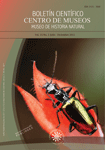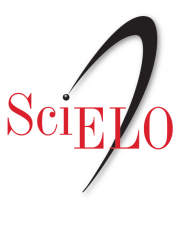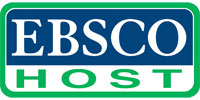Authors
Abstract
The analysis of arthropods chemical composition is important in taxonomy for recognition of species difficult to differentiate, in ecology, for behavioral analyses, and in selectivity studies of artificial and natural compounds, and, therefore, it is important for pest control. The objective of this study was to evaluate the chemical composition of the T. urticae and T. evansi mites cuticle. Chromatographic analyses of extracts were performed by gas chromatography coupled to mass spectrometry (CGMS). Identification of compounds was based on the comparison of retention times with standards, on the Kovats' index calculation and the analysis of mass spectra obtained for each registered peak on the chromatogram. Relative concentration of compounds present in the cuticle, the polarity of these compounds and their total relative concentration, and the differential presence of compounds in the cuticle of the two mite species were evaluated. The most abundant compounds in the cuticle of both mite species were hexadecanoic acid (palmitic acid), 9,12-octadecadienoico acid (linoleic acid), 9,12,15-octadecatrienoic acid-methyl ester (methyl linoleate) and octadecanoic acid (oleic acid or stearic). T. urticae cuticle has from 2.07 to 3.67 times more hexane extractable compounds than T. evansi cuticle . The total polar compound concentration was 2.15 to 3.71 times higher in T. urticae and the quantity of the most abundant compounds present in both species was 2.34 to 5.66 times higher in T. urticae.
Keywords:
References
ALARIE, Y. JOLY, H. & DENNIE, D., 1998. Cuticular hydrocarbon analysis of the aquatic beetle Agabus anthracinus Mannerheim (Coleoptera: Dysticidae). The Canadian Entomologist, 130: 615-629.
ANYANWU, G.I.; DAVIES, D.H. MOLYNEUX, D.H. & PHILLIPS, A., 1997. Variation in cuticular hydrocarbons among strains of Anopheles (Cellia) stephensi Liston possibly related to prior insecticide exposure. Annals of Tropical Medicine and Parasitology, 91 (6): 649-660.
ANYANWU, G.I. MOLYNEUX, D.H. & PHILLIPS, A., 2000. Variation in cuticular hydrocarbons among strains of the Anopheles gambiae sensu stricto by analysis of cuticular hydrocarbons using gas liquid chromatography of larvae. Memórias do Instituto Oswaldo Cruz, 95 (3): 295-300.
BIDOCHKA, M.J. & KHACHATOURIANS, G.G., 1997. Basic proteases of entomopathogenic fungi differ in their adsorption properties to insect cuticle. Journal of Invertebrate Pathology, 64: 26-32.
BLOMQUIST, G.J.; NELSON, D.R. & RENOBALES, M., 1987. Chemistry, biochemistry, and physiology of insect cuticular lipids. Archives Insect Biochemistry and Physiology, 6: 227-265.
BLOMQUIST, G.J. & BAGNÈRES, A.G., 2010. Introduction: history and overview of insect hydrocarbons Insect Hydrocarbons: Biology, Biochemistry and Chemical Ecology. Cambridge University Press, Cambridge Press. 506p.
CHIAVEGATO, L.G. & MISCHAM, M.M., 1981. Efeito do ácaro Tetranychus urticae (KOCH, 1836) BOUDREUX; DOSSE, 1963. (Acari: Tetranychidae) na produção no morangueiro (Fragaria spp.). Científica, Campinas, 9: 257-266.
DOI, M. NEMOTO, T. NAKANISHI, H. KUWAHARA, Y. & OGUMA, Y., 1997. Behavioral response of males to major sex pheromone component (Z,Z)-5,25-hentriacontadiene, of Drosophila ananassea females. Journal of Chemical Ecology, 23: 2067-2078.
FILGUEIRA, F.A.R., 2000. Novo manual de olericultura - agrotecnologia moderna na produção e comercialização de hortaliças. UFV, Viçosa. 402p.
FRAGOSO, D.B. GUEDES, R.N.C. PICANÇO, M.C. & ZAMBOLIM, L., 2002. Insecticide use and organophosphate resistance in the coffee leaf miner Leucoptera coffeella (Lepidoptera: Lyonetiidae). Bulletin of Entomological Research, 92: 203-212.
GUANILO, A.D., 2007. Busca de Tetranychus evansi e seus inimigos naturais no Peru e no norte da Argentina: Dissertação de mestrado, Universidade de São Paulo, Escola Superior de Agricultura “Luiz de Queiroz”, Piracicaba. 186p.
GULLAN, P.J. & CRANSTON, P.S., 1998. The insects: an outline of entomology. Chapman & Hall, London. 491p.
HELLE, W. & SABELIS, M.W., 1985. Spider mites: their biology, natural enemies and control. V. 1A. Elsevier, Amsterdam. 405p.
HIROAKA, H. MORI, N. OKABE, K. NISHIDA, R. & KUWAHARA, Y., 2003. Chemical ecology of astigmatid mites LXIX. Neryl formate [3,7-dimethyl-(Z)-2,6-octadienyl formate] as the alarm pheromone of an acarid mite, Histiogaster rotundus Woodring (Acari: Acaridae). Applied Entomology and Zoology, 38 (3): 379-385.
HORNE, G.L. & PRIESTMAN, A., 2002. The chemical characterization of the epicuticular hydrocarbons of Aedes aegypti (Diptera: Culicidae). Bulletin of Entomological Research, 92: 287-294.
HOWARD, R.W., 1993. Cuticular hydrocarbons and chemical communication: 179-26 (en) STANLEYSAMUELSON, D.W., NELSON, D.R. (eds.) Insect lipids: chemistry, biochemistry and biology. University of Nebraska Press, Lincoln.
JOHNSON, C.A. VANDER MEER, R.K. & LAVINE, B., 2001. Changes in the cuticular hydrocarbon profile of the slave-maker ant queen, Polyergus breviceps Emery, after killing a Formica host queen (Hymenoptera: Formicidae). Journal of Chemical Ecology, 27 (9): 1787-1804.
JUÁREZ, P., 1994. Inhibition of cuticular lipid synthesis and its effect on insect survival. Archives of Insect Biochemistry and Physiology, 25 (3): 177-191.
KOVATS, E., 1965. Gas chromatographic characterization of organic substances in the retention index system. Advances in Chromatography, 1: 229-247.
LAPOINTE, S.L. HUNTER, W.B. & ALESSANDRO, R.T., 2004. Cuticular hydrocarbons on elytra of the Diaprepes root weevil Diaprepes abbreviatus (L.) (Coleoptera: Curculionidae). Agricultural and Forest Entomology, 6: 251-257.
LIEPERT, C. & DETTNER, K., 1996. Role of cuticular hydrocarbons of aphid parasitoids in their relationship to aphid-attending ants. Journal of Chemical Ecology, 22: 695-706.
LU, X. ZHAO, M. KONG, H. CAI, J. WU, J. WU, M. HUA, R. LIU, J. & XU, G., 2004. Characterization of complex hydrocarbons in cigarette smoke condensate by gas chromatography–mass spectrometry and comprehensive two-dimensional gas chromatography–time-of-flight mass spectrometry. Journal of Chromatography, 43: 265-273.
MAHAMAT, H. & MIN, J.X., 2000. Cuticular hydrocarbon composition and taxonomic differentiation of phlebotomine sandfly species (Diptera: Psychodidae) in Kenya. Journal of Medical Entomology, 35: 778-781.
MALUF, W.R. CAMPOS, G.A. & CARDOSO, M.D., 2001. Relationship between trichome types and spider mite (Tetranychus evansi) repellence in tomatoes with respect to foliar zingiberene contents. Euphytica, 121: 73-80.
MORAES, G.J. & FLECHTMANN, C.H.W., 2008. Manual de Acarologia: acarologia básica e ácaros de plantas cultivadas no Brasil. Holos, Ribeirão Preto. 288p.
MURATORI, F. RALEC, A.L. LOGNAY, G. & HANCE, T., 2006. Epicuticular factors involved in host recognition for the aphid parasitoid Aphidius rhopalosiphi. Journal Chemical Ecology, 32 (3): 579-593.
NATION, J.L., 2002. Insect physiology and biochemistry. CRC Press, London, New York. 485p.
NELSON, D.R. CARLSON, D.A. & FATLAND, C.L., 1988. Cuticular hydrocarbons of tsetse flies II. Glossina fuscipes, G. palpalis, G. p. gambiensis, G. tachinoides, and G. brevipalpis. Journal of Chemical Ecology, 14 (3): 963-987.
NELSON, D.R. & CHARLET, L.D., 2003. Cuticular hydrocarbons of the sunflower beetle, Zygogramma exclamationis. Comparative Biochemistry and Physiology, 135: 273-284.
NELSON, D.R. TISSOT, M. NELSON, L.J. FATLAND, C.L. & GORDON, D.M., 2001. Novel wax esters and hydrocarbons in the cuticular surface lipids of the red harvester ant, Pogonomyrmex barbatus. Comparative Biochemistry and Physiology, 128: 575-595.
PAGE, M. NELSON, L.J. HAVERTY, M.I. & BLOMQUIST, G.J., 1990. Cuticular hydrocarbon as chemotaxonomic characters for bark beetles: Dendroctonus ponderosae, D. jefreyi, D. brevicomis, and D. frontalis (Coleoptera: Scolitydae). Annals of the Entomological Society of America, 83: 892-901.
PHILLIPS, A. SABATINI, A. MILLIGAN, P.J.M. BOCCOLINI, D. BROONIFIELD, G. & MOLYNEUX, D.H., 1990. The Anopheles maculipennis complex (Diptera: Culicidae): comparison of the cuticular hydrocarbon profiles determined in adults of five palaeartic species. Bulletin of Entomological Research, 80: 459-464.
PICANÇO, M.C. SOTO, A. BACCI, L. FIDELIS, E.G. SILVA, G.A. DE SENA, M.E., 2007. Controle biológico das principais pragas de hortaliças no Brasil: 505-537 (en) ZAMBOLIM, L. (ed.) Manejo integrado de doenças e pragas hortaliças. UFV, Viçosa .
SARMIENTO, R.A., 2003. Resposta comportamental de artrópodes em teia alimentar de tomateiro: Dissertação de mestrado, Universidade Federal de Viçosa, Viçosa. 161p.
SATO, M.E. PASSEROTTI, C.M. TAKEMATSU, A.P. SOUZA FILHO, M.F. POTENZA, M.R. & SIVIERI, A.P., 2000. Resistência de Tetranychus urticae (Koch, 1836) a acaricidas, em pessegueiro (Prunus persica (L.) Batsch), em Paranapanema e Jundiaí-SP. Arquivos do Instituto Biológico, São Paulo, 67: 117-123.
THORNE, B.L. HAVERTY, M.I. & COLLINS, M.S., 1994. Taxonomy and biogeography of Nasutitermes acajutlae and N. nigriceps (Isoptera: Termitidae) in the Caribbean and Central America. Annals of the Entomological Society of America, 87: 762-770.
YE, G. LI, K. ZHU, J. ZHU, G. & HU, C., 2007. Cuticular hydrocarbon composition in pupal exuviae for taxonomic differentiation of six necrophagous flies. Journal of Medical Entomology, 44 (3): 450-45.
YOUNG, H.P.; LARABEE, J.K.; GIBBS, A.G. & SCHAL, C., 2000. Relationship between tissue-specific hydrocarbon profiles and lipid melting temperatures in the cockroach Blatella germanica. Journal of Chemical Ecology, 26: 1245-1263

 PDF (Español)
PDF (Español)
 FLIP
FLIP















